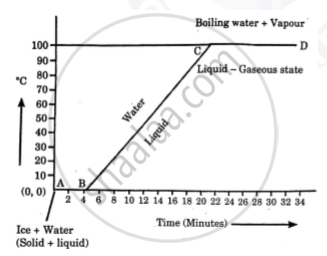Advertisements
Advertisements
प्रश्न
Match the columns.
| Column A | Column B |
| 1) Specific latent heat of fusion | a) Air saturated with vapour |
| 2) Specific latent heat of vaporisation | b) Solid converts into liquid |
| 3) Dew point temperature | c) liquid converts into gas |
उत्तर
| Column A | Column B |
| 1) Specific latent heat of fusion | b) Solid converts into liquid |
| 2) Specific latent heat of vaporisation | c) liquid converts into gas |
| 3) Dew point temperature | a) Air saturated with vapour |
APPEARS IN
संबंधित प्रश्न
State two factors upon which the rate of emission of thermions depends.
State the effect of an increase of impurities on the melting point of ice.
Explain the following:
The surrounding become pleasantly warm when water in a lake starts freezing in cold countries.
A molten metal of mass 150 g is kept at its melting point 800℃. When it is allowed to freeze at the same temperature, it gives out 75,000 J of heat energy.
- What is the specific latent heat of the metal?
- If the specific heat capacity of metal is 200 J kg-1 K-1, how much additional heat energy will the metal give out in cooling to -50℃?
What is meant by latent heat? How will the state of matter transform if latent heat is given off?
A thermally insulated pot has 150 g ice at temperature 0°C. How much steam of 100°C has to be mixed to it, so that water of temperature 50°C will be obtained? (Given : latent heat of melting of ice = 80 cal/g, latent heat of vaporization of water = 540 cal/g, specific heat of water = 1 cal/g °C)
Explain the following temperature Vs. time graph:

Why does weather become pleasant when it starts freezing in cold countries?
Define the term ‘specific latent heat of fusion’ of a substance.
The specific latent heat of vaporisation of steam is 2260 J/g. Comment on this.
Why does evaporation causes cooling and why is water used in hot water bottles?
Explain the meaning of greenhouse effect.
State two advantages of the high specific latent heat capacity of steam, which is about 226 × 104 J/kg?
Write the name.
The phase in which solid substances are converted into liquid.
Write scientific reason.
Even if boiling water is constantly heated, its temperature does not rise.
Who introduced the term latent heat?
The amount of heat energy required to melt a given mass of a substance at its melting point without any rise in its temperature is called as the ______.
20 g of ice at 0°C absorbs 10,920 J of heat energy to melt and change to water at 50°C. Calculate the specific latent heat of fusion of ice. Specific heat capacity of water is 4200 J kg-1 K-1.
